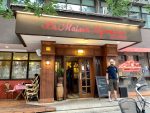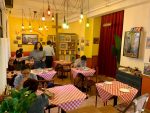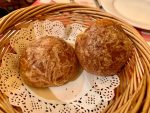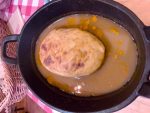In front of the Brazilian embassy
I finally made it to La Maison Lyonnaise in Beijing, located in the building that has seen so many eateries and more come and go, Hopefully this French restaurant will stay for a longer time. I think they changed little of what previously “Caravan”. Caravan has ceased operations as of February 14, 2020 after 5 years of operation. It served Moroccan and Cajun food. The 2nd floor is now basically vacant, where we previously had a book shop and a (great) Brazilian restaurant. About Caravan, see here earlier post with the details:
“Reality started to sink in” https://www.beijing1980.com/2020/02/28/reality-started-to-sink-in/
I asked the French owner for the special Lyon dishes, and see what he recommended and we ordered. The bread is nice and special. Then Lyon Quenelle, Saucisson de Lyon, strawberry cake. And a Belgian beer. See details about the dishes.
When I was often visiting Paris (for work) I always tried the regional restaurants. Sadly many have closed to make room for something like “Western International Restaurants”… So, good to have this in Beijing.
The service was nice, the food interesting. Not a cheap place. All customers were Chinese… (except me)
Lyon Quenelle de Brochet
See: https://www.regions-of-france.com/regions/rhone_alpes/food-gastronomy/lyon-quenelle#
The quenelles de brochet indeed represent the authentic Lyonnais cooking, made out with really local ingredients amongst which pike, usually fished in Rhône-Alpes streams, and free-range eggs from the neighboring French region of Bresse renowned for its quality poultry.
The well-known quenelles from Lyon are famous for their delicate mousse consistency and subtle taste of fish. The word “quenelle” is believed to originate from the German “knödel” meaning dumpling, but the Lyon recette has actually no equivalent in other countries – and even in French gastronomy.
or in French:
See: https://fr.wikipedia.org/wiki/Quenelle
La quenelle est une pâte moelleuse de forme cylindrique pochée dans l’eau bouillante. Elle est confectionnée à partir soit de farine, de mie de pain, de semoule ou de pâte à choux, mêlées de viande et pochées à l’eau ou dans un bouillon. Elles sont typiques dans la cuisine traditionnelle de plusieurs régions de l’Est de la France — en particulier les cuisines lyonnaise ou alsacienne. Elles peuvent se préparer en incorporant divers ingrédients, généralement des poissons (notamment le brochet), des viandes blanches (veau ou volaille), ou parfois de la moelle ou, en Alsace-Lorraine, du foie.
Saucisson de Lyon
Saucisson de Lyon is a large cured pork sausage in Lyonnaise cuisine. It sometimes includes some beef or a liqueur. It is similar to other large French cured sausages such as those of Arles, Lorraine, and Burgundy.
https://en.wikipedia.org/wiki/Saucisson_de_Lyon
and
Véritable Saucisson de Lyon
https://www.fondazioneslowfood.com/en/ark-of-taste-slow-food/lyon-saucisson/
Originally, the Lyon saucisson was a sausage made of a blend of meats: donkey or horse at the beginning, today beef, to which a mixture of lean pork is added (ham, shoulder, etc.). Its uniform, dark red filling, renowned for its delicacy, allows the cubes of lard to remain visible. It’s a lean sausage (only 10 to 12% fat), only consisting of lean trimmings, with the fat provided by the diced lard.









